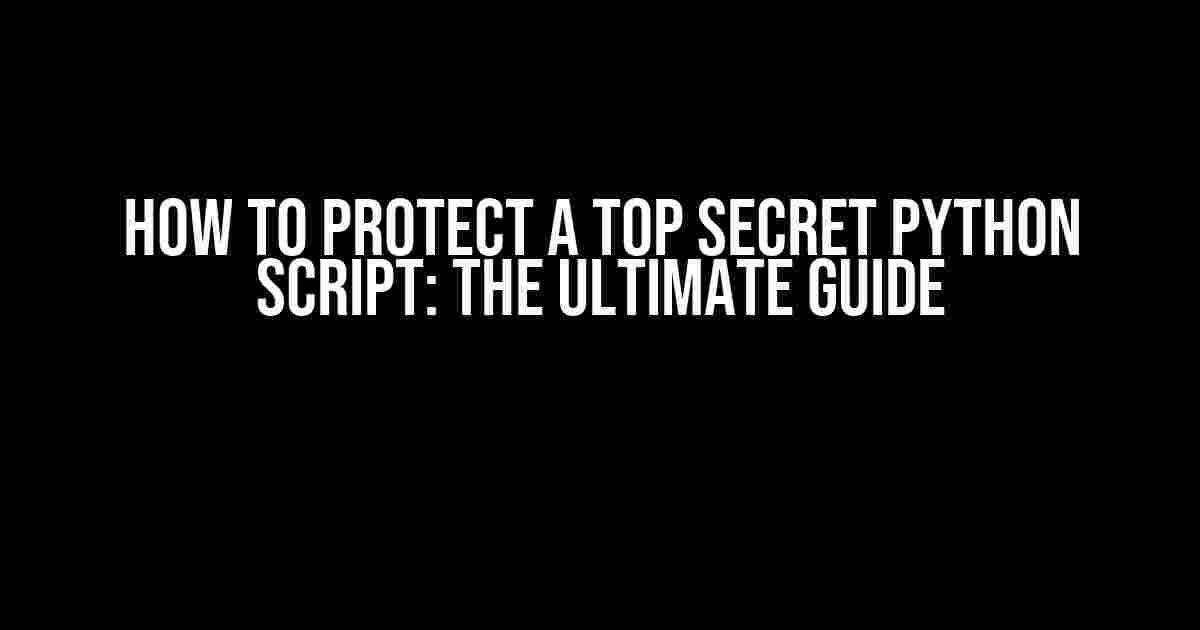Introduction
As a Python developer, you’ve poured your heart and soul into creating a top-secret script that’s going to change the game. But, as you know, with great power comes great responsibility. You can’t just leave your script lying around for anyone to find and copy. You need to take drastic measures to protect it from prying eyes. In this article, we’ll show you how to safeguard your top-secret Python script and keep it safe from unauthorized access.
Why Protect Your Python Script?
Before we dive into the nitty-gritty of protection, let’s talk about why it’s essential to safeguard your script. Here are a few reasons:
- Intellectual Property Protection: Your script is your intellectual property, and you don’t want others to steal or reproduce it without your permission.
- Competitive Advantage: If your script gives you a competitive edge, you don’t want others to gain access to it and level the playing field.
- Security Risks: A top-secret script can contain sensitive information, such as API keys or encryption algorithms, that could compromise your system’s security if they fall into the wrong hands.
Step 1: Use a Secure Development Environment
The first step in protecting your top-secret Python script is to use a secure development environment. Here are a few best practices to follow:
- Use a Virtual Private Network (VPN): A VPN encrypts your internet connection, making it difficult for hackers to intercept your data.
- Install a Code Editor with Encryption: Use a code editor like Visual Studio Code or PyCharm that offers encryption features to protect your files.
- Use a Secure Operating System: Consider using a secure operating system like Tails or Qubes OS that offers built-in security features.
Step 2: Obfuscate Your Code
Obfuscation is the process of making your code difficult to read and understand. Here are a few ways to obfuscate your Python script:
import base64
# original code
original_code = "print('Hello, World!')"
# obfuscate the code using base64
obfuscated_code = base64.b64encode(original_code.encode()).decode()
print(obfuscated_code)
This will output a string of gibberish that’s hard to decipher. However, keep in mind that obfuscation is not foolproof, and a determined hacker can still reverse-engineer your code.
Step 3: Use Encryption
Encryption is a more robust way to protect your Python script. Here’s an example of how to use the Fernet encryption algorithm to encrypt your code:
from cryptography.fernet import Fernet
# generate a secret key
secret_key = Fernet.generate_key()
# create a Fernet instance
f = Fernet(secret_key)
# original code
original_code = "print('Hello, World!')"
# encrypt the code
encrypted_code = f.encrypt(original_code.encode())
print(encrypted_code)
This will output a encrypted string that can only be decrypted with the secret key.
Step 4: Use a Secure Storage Solution
Now that you’ve obfuscated and encrypted your code, you need to store it securely. Here are a few options:
| Storage Solution | Features |
|---|---|
| Cloud Storage (AWS S3, Google Cloud Storage) | Secure, scalable, and accessible from anywhere |
| Encrypted USB Drive | Portable, encrypted, and offline storage |
| Password-Protected Archive | Encrypts your code using a password and compresses it into a single file |
Choose a storage solution that fits your needs, and make sure to follow best practices for secure storage, such as using strong passwords and two-factor authentication.
Step 5: Limit Access and Permissions
Even if you’ve taken all the necessary steps to protect your script, you still need to limit access and permissions to prevent unauthorized access. Here are a few ways to do this:
- Use Access Control Lists (ACLs): Set up ACLs to control who can access your script and what they can do with it.
- Use Role-Based Access Control (RBAC): Assign roles to users and define what actions they can perform on your script.
- Use Two-Factor Authentication: Require users to provide a second form of authentication, such as a password and a fingerprint, to access your script.
Step 6: Monitor and Audit
The final step in protecting your top-secret Python script is to monitor and audit access to it. Here are a few ways to do this:
- Use Logging and Auditing Tools: Implement logging and auditing tools to track who accesses your script and what they do with it.
- Use Security Information and Event Management (SIEM) Systems: Use SIEM systems to monitor and analyze security-related data from your script.
- Perform Regular Security Audits: Conduct regular security audits to identify vulnerabilities and weaknesses in your script and fix them before they can be exploited.
By following these six steps, you can protect your top-secret Python script from unauthorized access and keep it safe from prying eyes. Remember, security is an ongoing process, and you need to stay vigilant to ensure your script remains protected.
Conclusion
Protecting a top-secret Python script requires a combination of secure development practices, code obfuscation, encryption, secure storage, access control, and monitoring. By following the steps outlined in this article, you can ensure your script remains safe and secure. Remember, security is a top priority, and you should always be proactive in protecting your intellectual property.
Frequently Asked Question
Want to keep your top-secret Python script under wraps? We’ve got you covered! Here are five FAQs on how to protect your prized possession.
Q: How do I prevent others from reading my Python script?
A: Use encryption! You can use tools like PyInstaller or Py Encrypt to encrypt your script, making it unreadable to unauthorized users. This way, even if someone gets their hands on your script, they won’t be able to decipher the code.
Q: What’s the best way to store my sensitive Python script?
A: Store it in a secure repository! Consider using a private Git repository or a secure cloud storage service like Dropbox or Google Drive. Make sure to set up access controls and permissions to limit who can view or edit your script.
Q: Can I use a Python obfuscator to protect my script?
A: Yes, but with caution! Python obfuscators can make your code harder to read, but they’re not foolproof. A determined attacker might still be able to reverse-engineer your code. Use obfuscators in conjunction with other security measures for added protection.
Q: How can I prevent others from running my Python script?
A: Use access controls and digital signatures! Implement authentication and authorization mechanisms to limit who can execute your script. Digital signatures can also ensure that only authorized users can run your script.
Q: Are there any other security measures I should take?
A: Absolutely! Regularly update your dependencies, use secure communication protocols, and monitor your script’s execution environment. Also, consider using a code escrow service to store your script securely and release it only to authorized parties.




